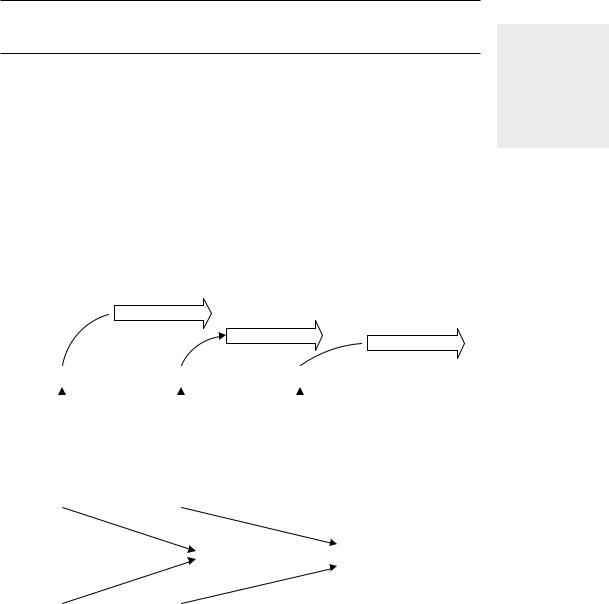
project_management_made_easy
.pdf
Get It Done Right!
Project Management on the Movie Set
One industry that does good project management in almost everything it does is the movie and television business. Whether it’s a TV commercial or a Hollywood blockbuster, there’s always a script and everyone goes over it with care. Before the cameras roll, there’s a walk-through. Everyone knows exactly what he or she will be doing. Why are moviemakers so careful? There are two reasons. First, it saves time and money. A film session works only if the direction, the sound, the action, and the lighting are all right. One mistake ruins the shoot—and that costs lots of money. (We’re talking thousands of dollars an hour, even for a simple commercial.) The other reason is safety. Scenes involving stunts like crashing cars and falling people require very careful walk-throughs.
The Lesson: Learn from the best. Prepare together and the team will succeed.
ten plan to bring things under control. When I’m doing a small project that will take me only two hours, I spend half an hour writing the plan. That prevents the project from becoming a four-hour hassle.
When we’ve defined the problem or opportunity and then come up with a plan for a solution, there’s one more step of preparation. We ask: Do we have everything we need? Does each person know how to do his or her job? If so, we’re ready to go. If not, then we get ready—we get the right people, we buy the supplies, we walk through the plan and make sure everyone knows his or her part.
When you have everything you need and everyone understands his or her part in the plan, you’re ready for action.
Do: Action, Tracking, and Control
Now, the team gets moving. Each step of the plan is executed. The work gets done. And while it is getting done, you—the project manager—make sure it gets done. We make sure each person has what he or she needs to start working, we check that nobody gets stuck, and we check each job when it is done. If every small step is done right, then the whole project will come in on time, within budget, and with high quality. That’s what it means to get it done right!
Even when we are doing the work ourselves on a one-person project, we should still keep track of our work and check off the steps as we go. Cooks make sure every ingredient goes into the cake; we should do our work with the same care.
7

Project Management for Small Business Made Easy
We can understand the idea of control by thinking about a car trip. To get safely to the right destination, we need to control our driving in these six ways:
Stay on the road. We keep an eye out while we’re driving. If we start to drift out of lane, we correct our course. Similarly, if the task isn’t getting done right, we stop, adjust, and do it right.
Eliminate repeating distractions. If the reason we drifted out of lane is that our pet cat is jumping around the car, we stop the car and put the cat in a carrier before we have an accident. Similarly, if we keep getting interrupted or our tools aren’t working or someone isn’t showing up on the job, we take care of this problem before it derails the project.
Keep up to speed. We want to arrive on time. So we make sure that we reach each milestone—each stop along the way—on time. If we’re running behind, we take fewer breaks or speed up our driving. If we can’t do that, we have to adjust our schedule.
Follow the route. We make sure not to get lost when we’re driving. On a project, our plan is like a road map. We make sure we follow all the steps in the right order.
Deal with roadblocks. We might come upon road construction and be told to take a detour. In that case, we need to come up with a miniplan, a small project to deal with the roadblock. We want to make sure we don’t get lost and we want to adjust our route and our schedule to get to our destination in the best way that we can. On a project, if we lose a worker, some supply doesn’t arrive, or a technique doesn’t work, we need to replan and readjust.
Handle any really big problems. Once in a while, things go so wrong that we need to revise our plan altogether. Say the car breaks down on the way to an important out-of-town meeting. Maybe it’s time to rent a car or head for the airport—or reschedule the meeting.
As you can see, there are various levels of control, from very low to very high. Some take seconds; others might take hours. To succeed, we need to do all of them. It’s not as hard as you might think. Here’s what they all have in common:
8

Get It Done Right!
Pay attention.
Decide what to do.
Take action fast.
Make sure you’re back on course.
There is a method for this called Plan, Do, Check, Act (PDCA), which we will discuss in Chapter 16, Quality: Eliminate Error.
When we pay attention to what’s going on and make the right response— not too big and too small—we roll rapidly in the right direction. We keep doing that until all the steps are done and we’re ready to follow through.
Follow Through: Delivery and Maintenance
When all the work is done, the project isn’t really complete yet. Exactly what we need to do will vary from one project to the next. Here’s a checklist; do any of these that you need to do on each project.
Deliver the result. Physically send the product to the customer and make sure he or she gets it.
Install the product. Some items require physical assembly or installation. Either we do this or we make sure that the customer does and that he or she has it working right.
Test end to end to make sure everything is working right.
Provide training or instructions, including training for new people who might come later, after the customer is using the product. We must make sure that this training lets the customer use the product and get benefits. It can’t be just off-the-shelf training that says, “Here’s how it works and what to do.” Training must be focused on real benefits to your business or the customer.
Plan for operation and maintenance, also called production support. Who will grease the wheels every year? Who does the customer call when the thing breaks?
Ensure customer delight. Check with the customer to make sure that he or she has everything needed and expected and is delighted with you and your company. If not, make it right before it’s too late.
Close the contract. Get paid and make sure all your vendors get paid and all contracts are signed off.
9

External projects make you
money. Internal projects get your business running right.
Project Management for Small Business Made Easy
When you have done all of these, you have a completed project and a delighted customer.
Internal and External Projects
Some projects are internal. They don’t make money directly, but they change the way you work. Maybe you install a new bookkeeping system or you launch a new advertising campaign. For these projects, your customer is inside the company. In fact, your customer may be you! Still, you want to do them well. When an internal project is complete, then you should have a newer, easier way of working. It should help you do a better job and be more efficient. You should see less hassle and a bigger bottom line.
External projects are projects for customers. When we succeed on an external project, we make money and delight the customer. There are several great things about delighted customers:
Delighted customers come back for more. That’s how we get repeat business.
Delighted customers refer their friends and colleagues. That’s how our business grows.
Delighted customers provide references and give us examples for case studies. That’s how we show new customers what we do, speeding up our sales cycle to get more new business.
Delighting customers is what small business is all about. Sure, we want to make money. But if that were all there was to it, we probably wouldn’t run our own business. In small business, we and our teams get joy from a job well done, from helping a customer solve a problem. We succeed by helping others.
Conclusion: Project Management for Your Business
In the next 21 chapters, you’ll learn all you need to know to make projects work. I hope that you’ll make this book a workbook. Maybe you’re already working on a project or you know what opportunity or problem you want to start with. If so, dive in. If not, take some time to think about which project matters most to your business. Is there one big roadblock in your way?
10

Get It Done Right!
Is there something that keeps going wrong, over and over? Or is there a big opportunity—a chance to grow or change your business? If you’ve taken some time to think about that, read Chapter 2, Small Business Projects, for some ideas. You can also go out to the web site for this book, www.qualitytechnology.com/DoneRight, and pick up a survey to help you figure out what your next project should be, along with plenty of other templates and tools.
11

Chapter 2
Small Business
Projects
WHEN BIG COMPANIES THINK ABOUT PROJECTS, THEY ARE USU-
ally talking about teams of ten or 50 or over a hundred working for months or years. In small businesses, we are talking of teams of one, or three, or five and a project might get done in a week. Even so, I think project man-
agement is even more important for small companies than for big ones. A big company can afford to blow a few million dollars and just write it off. For example, one large state identified over 25 projects in trouble that were an average of over $4 million over budget. That’s $100 million down the tubes! I can’t afford to waste $1,000. And I bet you’re in the same boat.
So, project management is about success for your business. In this chapter, you’ll learn:
where external and internal projects fit into your business
the eight ways projects benefit a business
who’s who on a project
and the 14 questions to ask on every project
12

Small Business Projects
Where Do Projects Fit into Your Business?
In Chapter 1, Get It Done Right! we talked about external projects for your customers and internal projects to improve your business. Figure 2-1 will help you figure out which type of projects you do at your company.
Some companies focus on external projects—they do unique, custom work for their customers, and the customers pay when they get it done right! In Figure 2-1, I call these Type 1 companies. Other companies, such as manufacturers, wholesalers, and retailers, make money by making or selling products or buying and selling products. In Figure 2-1, these are called Type 2 companies. Both types of companies benefit from projects and from good project management, but in different ways.
Company Type 1:
Projects for
customers  Delighted Customer
Delighted Customer
Delighted Customer
 Delighted Customer
Delighted Customer
Project 1 |
|
|
|
Project 2 |
|
|
|
|
Project 3 |
|
|||||
|
|
|
|
|
|
|
|
|
|
|
|
|
|
|
|
|
|
|
|
|
|
|
|
|
|
|
|
|
|
||
Support |
|
|
|
|
Support |
|
|
|
|
|
|
|
Support |
|
|
|
|
|
|
|
|
|
|
||||||||
|
|
|
|
Production Support of Projects |
|||||||||||
|
|
|
|
|
|
|
|
|
|
|
|
|
|
|
|
|
|
|
|
|
|
|
|
|
|
|
|
|
|
||
|
|
|
|
|
|
|
|
|
|
|
|
|
|
||
Project 1 |
|
|
|
Project 3 |
|
|
|
|
|
|
|
|
|||
|
|
|
|
|
|
|
|
Add |
|
|
|
|
|
|
|
|
Develop |
new |
|
|
|
|
2nd |
product |
|||||||
|
|
|
|
|
|
||||||||||
|
|
|
|
|
|
|
|||||||||
|
|
product |
|
|
|
|
|
||||||||
|
|
|
|
|
|
|
|
|
|
|
|||||
|
|
|
|
|
|
|
|
|
|
|
|
|
|||
|
|
|
|
|
Production Delivers Value |
||||||||||
|
|
|
|
|
|
|
|
||||||||
|
|
|
|
|
|
|
|
|
|
|
|
|
|||
|
|
|
product |
|
|
|
2nd |
product |
|||||||
|
Improve |
|
|
|
|
|
|
|
|||||||
|
|
|
|
|
Market |
|
Company Type 2: |
||||||||
|
|
|
|
|
|
|
|
|
|||||||
|
|
|
|
|
|
|
|
|
|
|
|||||
Project 2 |
|
|
|
Project 4 |
|
|
|
|
|
|
Projects lead to |
||||
|
|
|
|
|
|
|
|
|
|
|
|
|
|
production value |
|
|
|
|
|
|
|
|
|
|
|
|
|
|
|
||
Figure 2-1. Projects for two types of companies
External Projects: Making Money from Projects
Type 1 companies do external projects. Their customers pay for them to finish projects and deliver results. Here are some examples:
Small businesses need
project success— we simply can’t afford to waste money the way big companies do.
13

Listen to your customers.
They’ll tell you what you need to improve. Then put a deadline on that improvement and make it a project.
Project Management for Small Business Made Easy
A law firm that handles cases for clients
A catering company that supplies food and beverages for weddings and parties
A web design company that might make a web site for your business
An architect and a construction company that do renovations or build buildings for people or for other companies
A production company that makes TV commercials
Type 1 companies may work for consumers or for other businesses. They may offer products, services, or solutions. They might be in manufacturing or be more white-collar. What all Type 1 companies have in common is that every job they do is unique. So each job must be done differently. That makes it a project. Type 1 companies generally have fewer clients than Type 2 companies and each client pays more money, because the company is doing specialized, custom work.
When Type 1 companies do good work on projects, they deliver on time, within budget, and give the customers everything they wanted and more. As a result, when the customers pay their bills, the company makes good money—lots of money for relatively little work. The company doesn’t lose money running around fixing things after the fact. And satisfied customers come back and bring their friends.
When a Type 1 company doesn’t do a good job at project management, here’s what happens:
Projects get done late.
Customers don’t get what they want or expect.
What customers get doesn’t work right and they are not satisfied.
On fixed-price projects, the company loses money.
On projects where the customer pays for the time spent, the customer is very unhappy.
There is a lot of conflict.
The customer won’t always pay the full bill.
The customer doesn’t come back and probably tells his or her friends not to work with the company, either.
As you can see, good project management is essential to a Type 1 com-
14

Small Business Projects
Do Your Projects Make Money?
If you do projects for customers, you already know some project management. Evaluate your ability and results with these questions:
Do your projects get done on time?
Do you make money on most projects?
Do your customers ever say, “This isn’t what I wanted?” Or is it easy to get thanks and referrals?
Do you keep track of work as it gets done? Do you keep track of time and money spent as you go along, or do you just figure it out afterwards?
Does your team have all the skills, tools, and support to get the job done right?
Don’t judge yourself, but do identify your strengths and weaknesses. Then, as you read Project Management for Small Business Made Easy, focus on getting better in the areas that most need improvement.
The Lesson: In work, everything connects like a chain. Honest assessment lets us find the weakest link, so we can make it stronger.
pany—projects are linked directly to customer satisfaction and profit.
Internal Projects: Working Smarter
Type 2 companies, on the other hand, make money by selling many of the same product or service to customers. Here are some examples:
A beauty parlor that sees many customers each day
A restaurant or store that buys things from manufacturers and sells to customers
A manufacturing company that makes something and sells it
A building supply or auto parts company that sells equipment, parts, and materials to other companies
A video store that rents and sells movies to customers
Since Type 2 companies don’t make money doing projects, it might seem that project management is less important for these companies. But that is not true. Projects simply have a different role in Type 2 companies. Instead of making money directly, projects in Type 2 companies help the company solve problems and work smarter, so they can stay in business and make more money.
Type 2 companies do projects for four reasons:
An internal project is an
investment that pays off by making the business better.
15

Project Management for Small Business Made Easy
To realize new opportunities or dreams. For example, you might launch a new product or open a new location.
To do occasional work. If you put out a new catalog once each season or once a year or if you do an annual inventory or run a closeout sale, that’s a project.
To solve problems. If your assembly line is breaking down, or you can’t hire good workers fast enough, or something else is wrong, you can launch a project to define the problem and solve it.
To work smarter. Here, we’re talking about effectiveness and efficiency. Effectiveness is about doing a better job. Efficiency is about doing the same job, only faster or at lower cost. Working smarter is important because, if you don’t work smarter, your competitors will. And when they do, they’ll have a better product, or better customer service, or lower prices. Then you’ll lose market share.
One way to work smarter is to use new technology. We might get a computer network or install a computer program that is designed to run our business. We might buy more fuel-efficient trucks or better equipment. But better technology only gives us the opportunity to work smarter and save money. Internal projects need to make sure that, when we’re done installing the new technology, we’re actually working in new ways, and that those new ways of working actually are more effective and more efficient. Otherwise, the new technology is just a waste of time and money.
More or Less Unique
Projects You Already Do
Make a list of projects that you already do. If you run a Type 2 company, what things come up occasionally, such as creating catalogs, running marketing campaigns or sales, doing inventory, cleaning shop, renegotiating contracts, and planning your next quarter or next year? Each of these is a project. Make a list of occasional or scheduled projects and make a list of projects you are working on now.
The Lesson: We’re all doing projects all the time. Once we realize it, we can do each one better.
16
